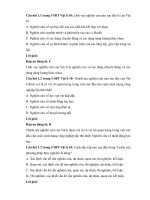- Trang chủ >>
- Khoa Học Tự Nhiên >>
- Vật lý
Campaign guide plight of the tuatha (1) 41
Bạn đang xem bản rút gọn của tài liệu. Xem và tải ngay bản đầy đủ của tài liệu tại đây (753.84 KB, 1 trang )
Campaign Guide
Chapter Three
Lore of Aeliode
History
Below is an excerpt from a work called “The Mysteries of
Eshu.” This story was first told by Eshu, an oracle of the
Dovani people. The Dovani have passed this tale down
through the generations. This particular tale was first
recorded by Livantus, scholar and Gardener of the Allamar. Livantus’ footnotes pertaining to his insight into this
account are included.
Except from “The Mysteries of Eshu”
As I, Eshu of the Dovani, settled down by my fire after the
day’s journey, a strange feeling came over me. The rustling
of the leaves in the trees above me and rivers flowing beside
me echoed in my ears. The caress of the cool autumn breeze
began to penetrate my body and it felt as though it flowed
through my soul. It was thus I knew that the world wished
to speak a truth to me if I wished to settle myself and listen.
I looked deep into my fire and saw.
At first I saw a void in the flames, a vast emptiness, a
space into which my soul felt like it would fall into and
be lost. It was in this emptiness that I beheld the gods.
Tulhesa strode proudly next to Paladrus, and they spoke of
things to come. They spoke of building worlds together; of
grand creations too numerous to understand, with which
they would fill the void. But they were not alone.
Tulhesa’s children1 followed close behind their mother,
clamoring in her shadow for her attention. ‘We think there
should be this’ her children said, ‘We think there should
be that.’ But the desires of her children were foolish and
vain and would have done naught but destroyed the worlds
which Paladrus and Tulhesa wished to build. Even though
Tulhesa listened to them and explained that their ideas were
foolish, her children wanted their ideas to become a part
of creation.
Soon the children grew angry with their mother and
words began to pass among them. ‘She is foolish to not
listen to us’ one said. ‘She is uncaring,’ said another. ‘If she
will not listen to us as we speak, we should plot to make
her listen,’ a third spoke.2
So Tulhesa’s children left her side and plotted. ‘If Paladrus would only leave our mother would heed our advice’
one said. ‘If we showed her how strong we are she would
listen to our counsel’ said another. ‘Let us seek the aid of
Ochesa3 the hunter, He will know how to force her to hear,’
a third spoke.
1. It is commonly thought that Tulhesa’s Children are the original forms of what today we would call dragons.
2. There is much debate concerning this passage. Some state that the three children who speak represent three types of dragonkind:
Metallics, Extra-planar, and Chromatics. Others state that only the Chromatics are the children of Tulhesa, and that the three are
the three original Chromatics. Still others state that we are not given any clues as to who the children are and that the assumption
that they are dragons is an unsubstantiated claim. I, though, feel that it is most likely that the children here are the Chromatics,
as they are generally known to be Tulhesa’s beloved children.
I further believe that the number that speak is not a claim of how many children she had as nowhere does the text state that all
her children have spoken when the three have spoken. It is most likely that case that only three children speak in a given moment
due to the inherent power of instances of triplicate occurrences. Only three children speaking allows the children to gain power
and perhaps focus magical workings in conjunction with the will of each other. The children must be using magic of some sort
to guide Volsung to do their bidding and act so uncharacteristically.
It should also be noted that the three children also have a pattern in which they speak. In each stanza, there is a shifting from what
appears to be a true or moral statement with the utterance of the first child, to a more ambiguous statement from the second,
while the third child’s statements seem either to be lies or foretelling dark deeds. This raises the question as to if the statements
are some kind of treatment on the nature of the differences of morality.
While there is no definitive answer as to the nature of the “children”, the moral lessons are there to be learned from
3. It is thought by some that Ochesa may be the truename of Volsung/Balar. This is one of the few places known where the name
is used. This use of a third name makes the nature of Volsung who is Balar even more complex. As a god it is said he does shift
between his two aspects and has different designs upon the world with each incarnation. I believe that Ochesa should be thought
of as a third aspect that rarely manifests, thus making Volsung who is Balar not a binary god, but a triple-aspect god. This of
course fits in well with this myth as it adds another layer of the numeral three into the tale, along with the three speaking children
and the three gods that are present.
40
